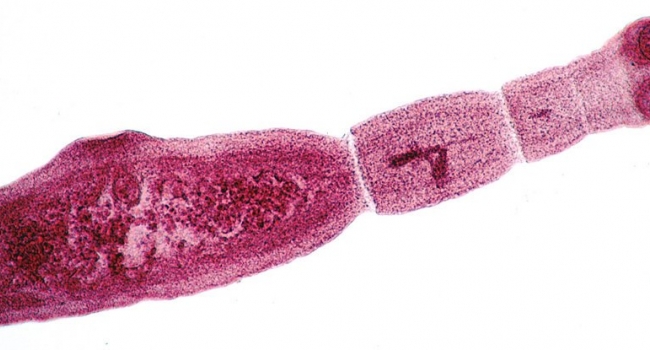- Latest news▼
-
19:41, April 25 Children’s Hospital Los Angeles and International Center of Professional Development Allergy/Immunology Conference

-
17:31, April 25 JAMA: patient grew long, curly eyelashes because of chemotherapy

-
11:08, April 25 Mpox epidemic declared in Republic of the Congo

-
08:31, April 25 OU: quitting smoking 4 times more likely to cure laryngeal cancer

-
01:20, April 25 Paralyzed man in China writes hieroglyphs using neural implants placed in his brain

-
15:11, April 24 Zombie deer disease possibly linked to hunters’ deaths

-
12:27, April 23 Appetite: Scientists found out the secret to the appeal of large portions of fast food

-
10:33, April 23 Scientists test new approach to fighting viruses

-
08:38, April 23 Ketamine may help with postpartum depression

-
22:12, April 22 Unhealthy amount of sugar found in baby food products of a well-known brand

-
19:41, April 22 Air pollution puts health of more than 1.6 billion workers globally at risk

-
17:25, April 22 Scientists found baked goods and lack of sleep to be more dangerous than alcohol

-
16:02, April 22 342 cases of measles recorded in Armenia so far in 2024

-
15:29, April 22 BrainStimulation: electrical brain stimulation alleviates anxiety and depression in the elderly

-
08:27, April 22 Cognitively stimulating jobs in midlife could lower dementia risk in old age, study finds

All materials
Dangerous tapeworm in your pet could kill you

Echinococcus multilocularis is a tapeworm that is normally found in rodents and other wild animals, including coyotes and foxes, but can spill over into cats and dogs – and even humans.
As Sciencealert reports, according to Emily J Jenkins, Associate Professor at Veterinary Parasitology and Public Health, University of Saskatchewan, dogs, and sometimes cats, carry the tiny tapeworms in their intestines, where they cause no problems for the pet.
In humans, the tapeworm behaves differently. It can invade the liver and spread throughout the abdomen and the rest of the body like a tumour.
Without early detection and aggressive treatment (surgical removal of the mass and antiparasitic drugs), the infection has a 50 per cent to 75 per cent mortality rate, potentially higher in people with compromised immune systems.
The first North American case of the liver form of E. multilocularis in a dog was spotted in British Columbia in 2009. It has since caused severe disease in at least seven dogs in Western Canada and four dogs in Ontario, a new region for the parasite.
Initially, it seemed like the first dog had a particularly nasty tumour invading its liver, spleen and stomach. But a microscopic examination of the "tumour" revealed something startling – hundreds of miniature tapeworms in their larval form.
The parasite eggs are extremely tough, immune to most common disinfectants and survive months to years in the environment.
Dogs become infected with the liver form of the parasite, which can be deadly, when they consume the parasite's eggs in coyote, fox and wolf scat. Dogs get the intestinal form (harmless to the dog, but dangerous to us) when they consume infected rodents.
This means that dogs can be exposed in any place where you might find coyotes and foxes, typically rural areas, but increasingly urban and suburban green spaces.
Dog owners — and gardeners and foragers — should be concerned. Both dogs and people can be exposed to the tapeworm eggs in dog, fox, coyote or wolf scat. People can be exposed through consumption of contaminated produce such as berries, herbs, greens, wild mushrooms or surface water.
Follow NEWS.am Medicine on Facebook and Twitter
- Video
- Event calendar
- Children’s Hospital Los Angeles and International Center of Professional Development Allergy/Immunology Conference
- First Armenian-German Conference entitled “Heart Failure Spring School”
- Allogeneic bone marrow transplant in case of hematological malignancy performed in Armenia for first time
All materials
- Archive
- Most read
month
week
day
- JAMA Oncology: Urine test can help rule out high-grade prostate cancer with almost 100% accuracy, study shows 1272
- Scientists grow human mini-lungs in lab 1157
- Next pandemic likely to be triggered by flu - scientists 920
- Scientists found baked goods and lack of sleep to be more dangerous than alcohol 842
- 342 cases of measles recorded in Armenia so far in 2024 800
- Blood test can determine who is at risk of developing multiple sclerosis - scientists 764
- Scientists develop new method to safely stimulate immune cells to fight cancer 764
- Cognitively stimulating jobs in midlife could lower dementia risk in old age, study finds 758
- BrainStimulation: electrical brain stimulation alleviates anxiety and depression in the elderly 706
- Unhealthy amount of sugar found in baby food products of a well-known brand 581
- Air pollution puts health of more than 1.6 billion workers globally at risk 577
- Ketamine may help with postpartum depression 565
- Appetite: Scientists found out the secret to the appeal of large portions of fast food 563
- Scientists test new approach to fighting viruses 547
- Zombie deer disease possibly linked to hunters’ deaths 442
- Find us on Facebook
- Poll





